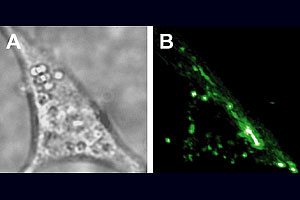 (left) A cell imaged with an optical microscope. (right) The same cell imaged by allowing the cell to absorb UCNPs and then irradiating it with infrared light. Each nanocrystal is one thousand times smaller than the width of a human hair. Image courtesy of PNAS."Like a silent black mist, nanoparticles began to come into the room underneath the west door...Inside the room, the particles appeared to spin and swirl aimlessly, but I knew they would self-organize in a few moments."
(left) A cell imaged with an optical microscope. (right) The same cell imaged by allowing the cell to absorb UCNPs and then irradiating it with infrared light. Each nanocrystal is one thousand times smaller than the width of a human hair. Image courtesy of PNAS."Like a silent black mist, nanoparticles began to come into the room underneath the west door...Inside the room, the particles appeared to spin and swirl aimlessly, but I knew they would self-organize in a few moments."
Thus proceeds Michael Crichton's 2002 thriller, Prey, as the protagonists face off against a malicious swarm of flesh-hungry nano-robots that are the offspring of a most unholy marriage of biological, computer science, and engineering research efforts.
Real science capabilities lag somewhat behind, but researchers succeeded recently in demonstrating an exciting new class of nanoparticle with potential applications in biological imaging. The new crystals, more formally known as lanthanide-doped upconverting nanoparticles (UCNPs), were fabricated and studied under the direction of principle investigators Bruce Cohen and James Schuck at Lawrence Berkeley National Laboratory's Molecular Foundry, and results were published on June 18th in a paper by Shiwei Wu and others in the Proceedings of the National Academy of Sciences (PNAS).
Happily, while Crichton's nanoparticles coordinated an attack on a your vital organs, these particles behave more like benign light bulbs. After allowing a living cell to absorb the UCNPs, researchers shine infrared laser light on the cell, and the nanocrystals within light up like a Christmas tree in red or green arrays of dots. These, in turn, can easily be spotted using an optical microscope and used to map out particle distributions within a cell, yielding information impossible to obtain by other methods.
The method, known as single-molecule imaging, has been demonstrated using other nanoparticle types, but UCNPs are unique because of their uncommon brightness and stability, and because they are powered by infrared light. This is both good for the studied cells, because infrared light is less damaging than visible or X-ray frequencies, and good for the people measuring them, because it can probe more deeply into tissue than other types of light. In fact, one prospect for future research is the imaging of entire animals.
